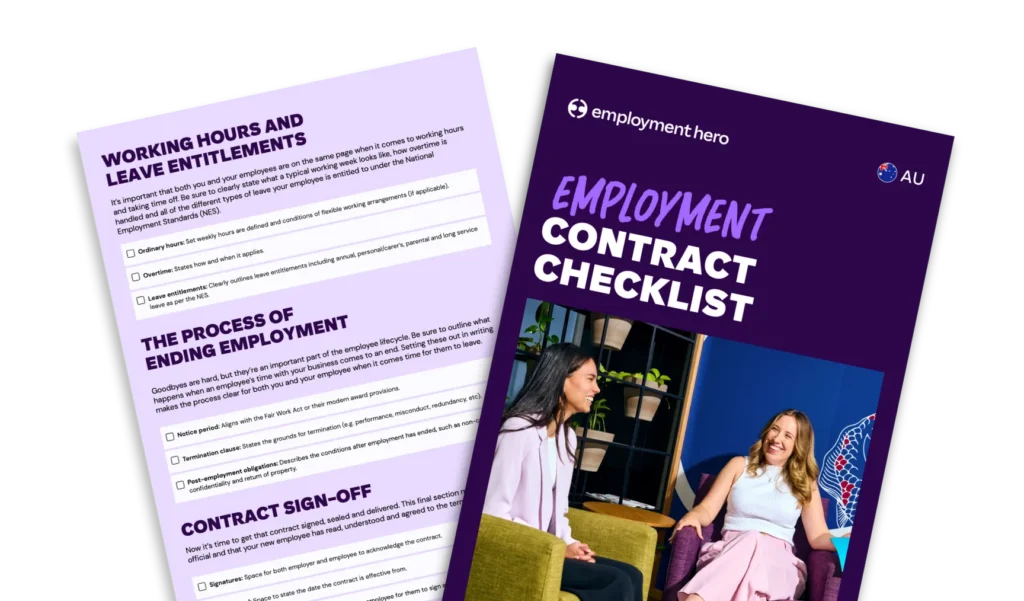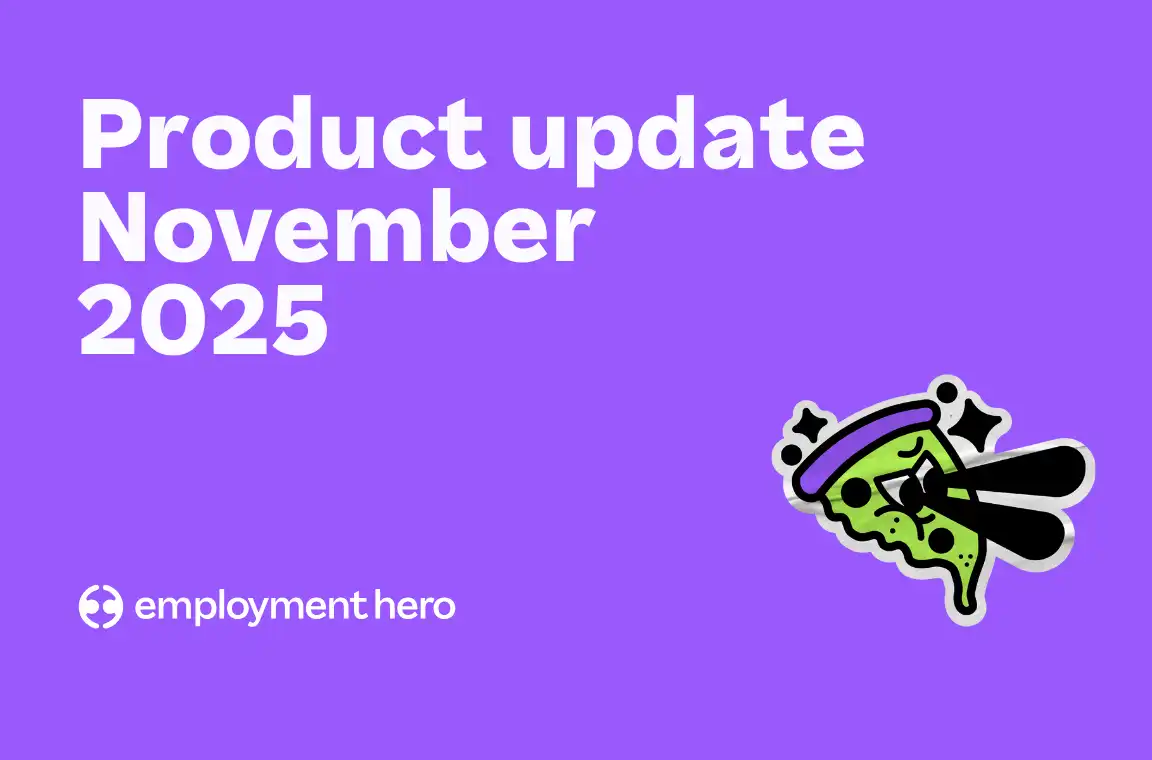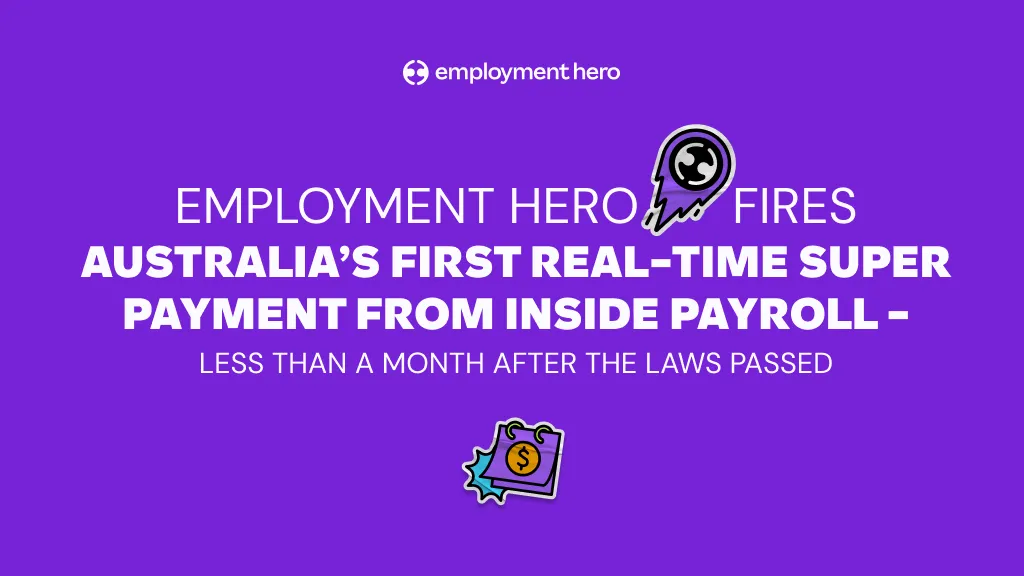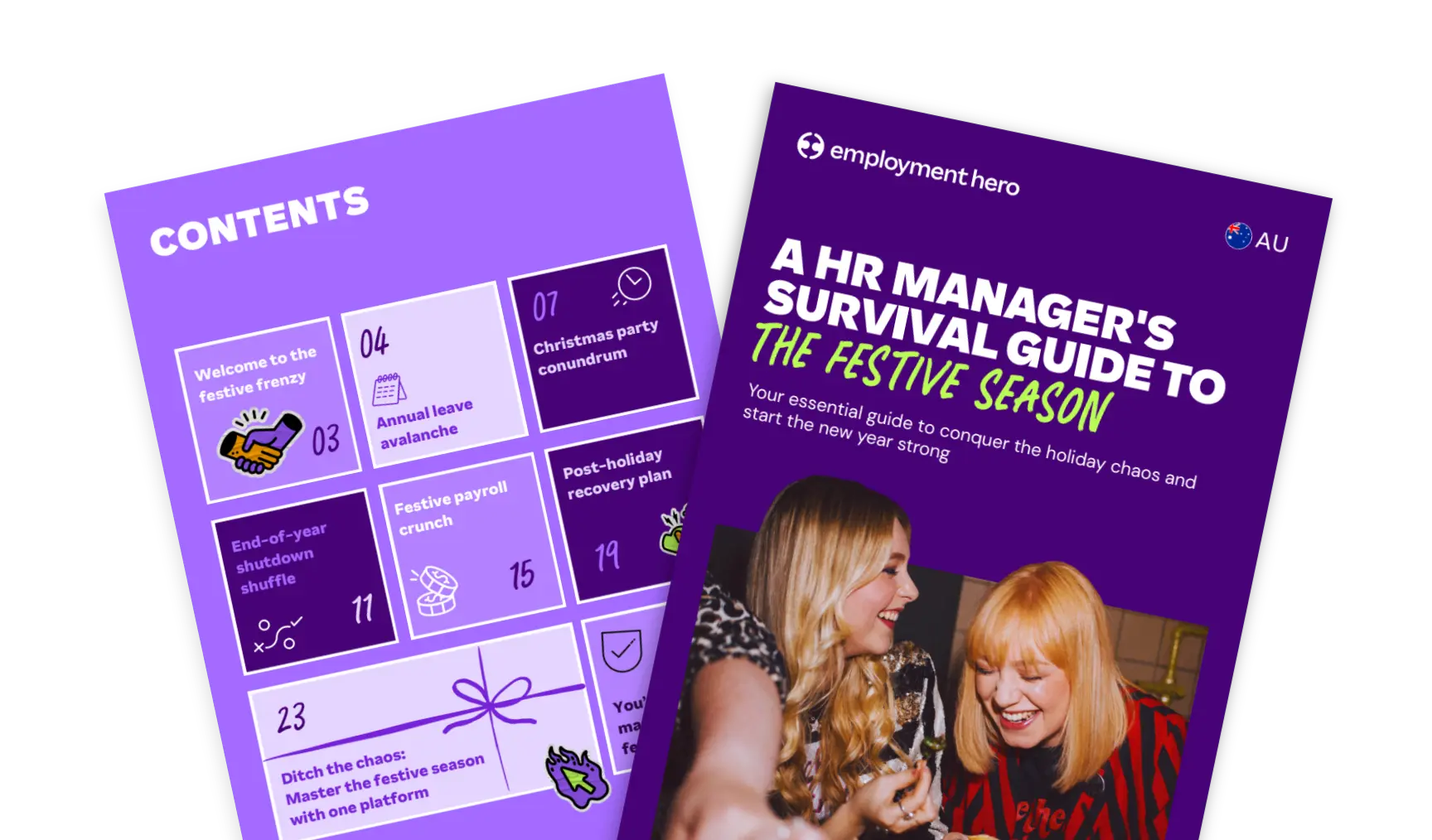Employment contract checklist
Published
Employment contract checklist
Published
Every small business owner knows that running a business is tough. You’ve got customers to keep happy, a team to lead and big targets to hit. And when you’re in the midst of bringing a new team member into the fold, the last thing you need is an employment contract that lets you down.
It’s the most important document between you and your employees. Think of it as your employment safety net that sets the tone of the employee/employee relationship. Get it right and you’ll avoid admin headaches, protect your bottom line and make sure everyone knows where they stand. Get it wrong and you and your new hires will feel the impact well into the future.
Whether you’re hiring your first employee or managing a growing team, this checklist will guide you through what to include, what to double-check and how to keep your contracts compliant. By taking a few extra steps now, you can feel confident that your contracts are not only legally sound but also reflect your company’s values and commitment to doing the right thing by your people.

The information in this checklist is current as at 8 October 2025, and has been prepared by Employment Hero Pty Ltd (ABN 11 160 047 709) and its related bodies corporate (Employment Hero). The content is general information only, is provided in good faith to assist employers and their employees, and should not be relied on as professional advice. Some information is based on data supplied by third parties. While such data is believed to be accurate, it has not been independently verified and no warranties are given that it is complete, accurate, up to date or fit for the purpose for which it is required. Employment Hero does not accept responsibility for any inaccuracy in such data and is not liable for any loss or damages arising directly or indirectly as a result of reliance on, use of or inability to use any information provided in this checklist. You should undertake your own research and seek professional advice before making any decisions or relying on the information in this checklist.
The importance of compliant employment contracts
If you’ve ever dealt with employee disputes or last-minute resignations that have come out of the blue, you know that things can get messy fast. The right contract clearly states the rules, protects your business and makes having those tough conversations a whole lot easier.
It’s also your first line of defence when it comes to meeting your legal obligations under the Fair Work Act and abiding by the National Employment Standards. If you find yourself leaving out key components of an employment contract or relying on a verbal agreement, you can run the risk of hefty fines, possible jail time and a whole lot of unnecessary stress.
What is an employment contract and why does it matter?
Like we said earlier, consider your employment contracts as the most important documents between you and your employees. It lays out exactly what’s expected of them and what they can expect in return.
For you, it’s a layer of protection for your business. It can help set clear boundaries, handle performance issues that may arise and answer any questions about entitlements and processes. When details like employee pay, leave and notice periods are laid out in a document, the chances for confusion significantly reduce.
Working with an independent contractor and not an employee? Download our independent contractor agreement.

What should be included in an employment contract?
Creating a clear, compliant employment contract is one of the most important steps in hiring a new team member. In Australia, employment contracts exist to formalise the working arrangement, while providing protections for both the employer and the employee. These protections are generally put in writing, setting out the rights, responsibilities and expectations of employment.
Whether you’re hiring a casual hospitality worker or a senior professional, taking the time to document the right details will help you manage your compliance obligations, while creating a great onboarding experience for every new employee.
To build a robust employment contract, you need to include specific information that protects both parties. Here’s what you need to cover:
Who’s involved: Employer and employee details
List your full legal business name and your employee’s full name. It sounds basic, but mix-ups happen, especially if you run several businesses or hire family members.
Be sure to add your business’s ABN/ACN and your main worksite address, so everyone knows exactly who’s involved.
Role and responsibilities: Job title and description
In the employment contract, write out exactly what the team member is responsible for, so there’s no awkward “I didn’t know that was part of my job” conversations later.
You want to be specific about the responsibilities of their role, pointing out all major duties and tasks unique to your business (e.g. opening up the shop, managing stock or handling client relationships). It’s also a good idea to state that the employee’s duties may be changed in the future, to give yourself a bit of flexibility.
Full-time, part-time or casual: Employment type and duration
Is your new hire a full-time, part-time or casual employee? Write it down, including their start date and, if relevant, an end date or review period. Accurately classifying each worker keeps you compliant and helps avoid confusion over penalty rates and leave.
If you’re not sure what defines a casual employee, take a look at our in-depth guide to hiring casual employees.
Modern awards: Coverage and classification level
The majority of employees in Australia are covered by an industry or occupation specific modern award. This sets minimum terms and conditions on top of those in the Fair Work Act, most importantly the relevant minimum wage. You should inform employees in their employment if a modern award applies to them and their classification level in the award.
Pay and perks: Compensation and allowances
When it comes to pay and perks, it’s all in the details. Outline their salary or pay rate (including overtime), any allowances they’ll receive and any other compensation like bonuses.
If your new hire is working when a penalty rate kicks (like on a weekend or public holiday), include details about them too. You want to be clear about how and when they’ll get paid, as well as include any entitlements they’re entitled to under a modern award or enterprise agreement.
When and where: Working hours and location
Every business is different, so it’s important to define the expected working hours. Are the expected hours of work 9am-5pm or are you engaging employees to work shift work?
You also need a state where your new hire will be working from. Can the role be done flexibly or is the role completely on-site? These are important details to include and set expectations from the very first day.
Leave entitlements: Annual, personal and more
Don’t leave employee leave entitlements to chance. Clearly state leave entitlements (include annual leave, sick/carer’s leave and long service leave). You may also want to include the process for how to apply for each type of leave.
Stating the leave types employees are entitled to under the National Employment Standards (NES) gives your team confidence they’ll get what they’re owed. It also helps cover your bases when the leave requests start rolling in.
Superannuation contributions
In the employment contract, be clear that you’ll make super payments as required by law, at the correct rate, at the correct time and into the employee’s nominated fund.
Don’t get caught off guard by the changes to super. Check out our Payday Super Hub for everything you need to know about these important changes.
How to end the employment contract: Termination and notice periods
In the employment contract, include the steps an employee needs to take to end their employment. How much notice do they need to give? What’s the process for returning equipment? Make sure all of these questions are covered so there’s no confusion or offboarding grey area.
Restraint clauses: Confidentiality and non-compete
If you want to keep your business secrets safe or prevent staff from taking clients after they leave the business, you’ll need to draft up confidentiality and non-compete clauses. There are strict guidelines on these, with potentially more changes to the law coming soon, so we suggest seeking employment advice on this (our team of HR advisors can help).
What clauses should employers consider for employment contracts
These optional clauses can help give you peace of mind:
- Probation periods: Want to make sure the person you’ve hired is right for the job? Set a clear probation window (usually 3–6 months).
- Intellectual property rights: State that anything your employee creates for the business belongs to the business.
- Dispute resolution processes: Outline a clear process for complaints or disagreements in the workplace.
Stay across your legal obligations with our handy checklist
Managing employment is not a set and forget process. While the template you put together two years ago might seem perfect, laws are continually changing in Australia. Modern awards, enterprise agreements and the Fair Work Act set strict minimums and your contracts must always reflect the most up-to-date requirements. To ensure you’re staying across your obligations, make sure you’ve got everything in our checklist ticked off.
Download the employment contract checklist now.
Frequently Asked Questions
Having a written employment contract is always a smart move. However, in Australia, a verbal employment contract still stands. Remember, a written contract gives both you and your employees a document to refer to if things ever go sideways.
Yes, but only with your employee’s agreement. If any changes have been made, make sure they’re all in writing and both parties have signed and agreed to the updated changes.
In Australia, the Fair Work Act and NES cover the whole country, but states and territories can add extra requirements at their own discretion, like extra long service leave entitlements or different public holiday rules. When hiring an employee in a different state or territory, be sure to check the rules and regulations of the jurisdiction they’re employed in.
Remember how we said that your employment contract is your compliance safety net? If you don’t have one, you’re opening your business up to risk. If there are conditions they’re not happy with, such as salary, try and negotiate the terms of employment.
Never force someone to sign an employment contract, but don’t proceed without a contract. Protect yourself and your business.
With Employment Hero, you can create, send and sign employment contracts in minutes. Our powerful employment platform has built-in Modern Awards and Fair Work conditions, helping you reduce the risk of costly errors. Whether you’re hiring full-time, part-time, casual or contract staff, you can customise each contract with dynamic fields that pre-fill employee details, pay rates and entitlements, all in one secure digital workflow.
Once your new hire has signed and returned their employment contract, it’s stored safely in the cloud, so you’ll never lose track of important documents again. Need to update terms after a pay rise or promotion? Simply issue a variation with a few clicks and share it with your team.
Want to see Employment Hero in action? Get in touch with one of our business specialists today to see how we can transform your contract management process.
Recruitment software can be the bridge between finding great talent and getting them onboard quickly. With our recruitment software and powerful tools like SmartMatch, you can manage every step of the hiring process, from posting roles to generating offer letters all in one central platform. Once a candidate is hired, you can start building your employment contract and easily onboard them in minutes, not days.
Register for the checklist
Related Resources
-
 Read more: Product Update: November 2025
Read more: Product Update: November 2025Product Update: November 2025
Welcome to the November 2025 product update from the Employment Hero team. We’ve got lots to share around Workflows, Rostering,…
-
 Read more: Payday Super pressure eased: Employment Hero fires Australia’s first real-time super payment from inside payroll – less than a month after the laws passed
Read more: Payday Super pressure eased: Employment Hero fires Australia’s first real-time super payment from inside payroll – less than a month after the laws passedPayday Super pressure eased: Employment Hero fires Australia’s first real-time super payment from inside payroll – less than a month after the laws passed
One month on, Employment Hero, Zepto and OZEDI deliver the first payroll-embedded super-clearing payment over the New Payments Platform (NPP),…
-
 Read more: HR Managers: Don’t just survive the festive season, master it
Read more: HR Managers: Don’t just survive the festive season, master itHR Managers: Don’t just survive the festive season, master it
Make year-end easier: manage leave, payroll, parties and shutdowns with confidence. Get practical tips for Australian SMEs. Download the free…























